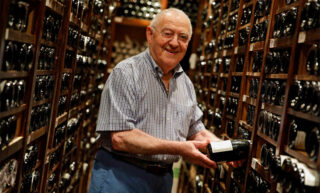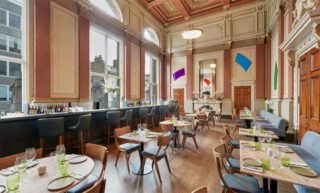Atrio forever
2023 was an emotional year for José Polo and Toño Pérez of restaurant Atrio in the small city of Cáceres in western Spain. Not only were the thieves of 45 of their most prized and irreplaceable bottles of wine, including a Château d’Yquem 1806, convicted, but they also received their third Michelin star, placing the sparsely populated region of Extremadura firmly on the gastronomic travel trail. Although the couple – in life and business – have entered into their seventh decade, they are still full of ambition. However, one day Atrio may be an Italian restaurant.
Before my Zoom conversation with José Polo, the host and sommelier of restaurant Atrio, I decide to wait discreetly until he brings up his relationship with chef Toño Pérez. I don’t have to wait long – within minutes he tells me how he and Toño met as teenagers and started dating soon after, how they partied in Torremolinos and visited many world cities. But they always returned to Cáceres, a monumental but small city roughly midway between Madrid and Lisbon. They never seriously considered starting their business in Barcelona or Madrid. Or London, like José Pizarro, that other famous gay Extremaduran chef. It may have been a sense of hope, freedom and optimism that pervaded the country after Franco’s dictatorship – an openness detectable to this day – that made them stay. It certainly shows the deep connection Pérez and Polo feel for their city and region, but also for its culinary potential. However, in the late 1980s, when they started the first incarnation of Atrio, the pull from elsewhere was less strong – the treasures of Spanish cuisine were, at best, still shimmering beneath the surface and waiting to be unveiled by the likes of Ferran Adrià and Juan Mari Arzak.
In their early years, Polo and Pérez spent much of their sparse money on traveling. While laughing, drinking and dining out with friends, they realized that opening a restaurant might be their destination in life. Although Pérez’s father had an obrador de pastellería, or pastry workshop, neither had thus far had any hospitality experience. But they had resolve, as history has shown. Atrio, 37 years later, has extended Spain’s gastronomic prowess to yet another region that, through the restaurant, can show its culinary feathers.
So, what is the essence of Extremaduran cuisine? For an answer one needs to understand the type of cultural landscape the Spaniards call the dehesa. It stretches out for roughly 20,000 square kilometers (half the size of the Netherlands or Switzerland) from Salamanca in the northeast to the Algarve in the southwest and is characterized by pastures and open forests of mostly oaks, among which are the cork oak and the holm oak. Towns are far apart with vast emptiness in between. “There is almost nothing between Cáceres and Trujillo [the next town 45 kilometer to the east],” Polo says. Plots of land are fenced off by age-old stone walls and simple wire fences, through which scenic paths wind their way up and down the hills. Under the trees, the famous black Iberian pigs roam around and feed themselves on acorns. Air-dried ham, jamón iberico, is one of the main drivers of the economy, but agriculture is varied. Besides pigs, farmers keep goats, chickens and an odd cow. The forest is also a source of mushrooms and honey.
Hence, the core of Extremaduran cuisine is, without any doubt, the Iberian black pig. It also is the red thread that runs through Toño Pérez’s twenty-two-course tasting menu, which says as much about the versatility of the cerdo ibérico, as it does about the mastery of Pérez’s art. All the dishes, savory and sweet, had some part of the pig as an ingredient, although I didn’t even see a sliver of the ubiquitous jamón ibérico! Boring? Excessive? Nope, not by any means! Through Pérez’s combinations each dish was unique, delicious and often playful. To accomplish that, Pérez allows himself to stretch his sourcing area to the Andalusian coastline. Our choice of a brilliant Remelluri Rioja Blanco 2010 can be seen as a response to the prominent role of fish and seafood.
Toño Pérez and José Polo ©Atrio
At our recent lunch, manteca colorá, or spiced red lard, gave the tuna belly a deeper flavor. The collagen thickened pork sauce made the lobster with green curry and lemongrass take off. Then there was a skewer with apple and smoked eel, a classic combination, given a twist by the loncheja, a cut of the pork’s ear, some courses later followed by porco tonnato, succulent slices of pork sausage with a foamy tuna sauce. And what to think of a profoundly flavorful flan of pork jowl with a wild mushroom reduction (cooked for 70 hours at 45 degrees Celsius) generously topped with caviar that makes your umami sensitive taste buds go haywire?
On the non-marine side, Pérez offers, for example, an airy puff pastry enriched with smoked bacon. And a heavenly manifestation of the traditional oil, tomato and ham sandwich: mayonnaise ice cream, diced Iberian ham and a veil of jellified tomato water on top of an intense, silky soup of the same ingredients. Not until the eighteenth bite, like a continuously postponed climax, a proper cut of pork was served: the main course if you will. The presa iberica, or Iberian prey, a prime cut from the shoulder – marbled, juicy and soft – came with carrot cream, slices of carrot in chimichurri and the lightest, yet creamiest black pepper sauce. You may have been vaguely aware of the adaptability of the four-trottered mud-rolling cob roller, but it nowhere becomes so apparent as during lunch or dinner at Atrio.
To bring some structure into the menu, the dishes are loosely clustered around five themes. Snacks (the amuses bouches), and ‘Cochinito [piglet] goes to the beach’ (highlighting pork’s ability to combine with fish – in our case, tuna, salmon and smoked eel) count three courses each. ‘When the cochinito takes a break in the dehesa’ consists of eight dishes that have a more continental character, although four small plates once again included an element from the ocean, like squid and scallops, but these served more as a blank canvas for the pig to shine, as the squid with a pork’s ear stew and a black ink brioche demonstrated.
After the subsequent (small) main courses (part 4), the menu was rounded off by four desserts. Mind you, aged ham is even able to give chocolate a new dimension.
To honor his roots – Pérez comes from the neighboring town of Casar de Cáceres – he also serves a dessert of creamed Torta del Casar, the well-known local sheep’s milk cheese with a soft core that is typically scooped out. Its richness was brightened up by quince gel, matcha tea flavored spunge and olive oil biscuit.
Despite all its culinary splendor, a visit to Atrio starts with a descent into its illustrious wine cellar. It was never a question who would be selecting the wines and who would be responsible for the kitchen. Pérez, Polo says, is the introverted one, while Polo, as we witnessed, loves to talk. So, Pérez became responsible for the kitchen, and Polo for the wine. As they never seem to take half measures, Polo started buying wines ambitiously: Vega Sicilia, Château Haut-Brion, and other highly coveted nectar. One of his first orders added up to the price of a small apartment in a well-heeled neighborhood of Madrid. After a sleepless night and an early morning phone call, the wine trader offered to cut the order in half and grow the wine collection in increments. But by then, Polo had recovered from a bout of buyer’s remorse and proceeded on the chosen path. Now the fame of Atrio’s wine collection, particularly strong on classic French wines, has spread far beyond Spain’s borders and has even attracted attention from the world of organized crime. How they managed to break into the highly secured wine cellar feels like an episode of the Netflix hit Lupin. Although the perpetrators have been caught and convicted, some exceptional wines are lost for posterity, a deeply traumatizing experience for Pérez and Polo.
The couple, now in their early sixties, have reached the pinnacle of their profession. With three stars and top-of-the-line accommodation in the historic center of Cáceres, the two have started focusing on their legacy. Their Fundación Atrio Cáceres aims, among other things, to improve children’s chances in life by providing musical education. Neurologists have proven, Polo says, that practicing music develops one’s capabilities to learn languages and maths. Since a couple of years these efforts are expanded with a musical festival. Meanwhile, they train local youngsters in the kitchen and the front of the house, hoping to secure continuation of their enterprise, which, ultimately, has to fund the foundation. Polo shows a sense of realism when he says, half-jokingly, that Atrio may eventually become an Italian restaurant, but not as long as they are around. Atrio – the hotel and restaurant – is their life’s work, for which they stayed in Cáceres, and Pérez and Polo would like it to last beyond their lifetime. Atrio forever!
Restaurante Atrio
Plaza de San Mateo 1
10003 Cáceres
Spain
T: +34 927 242 928
A version of this article (in Norwegian) has been published in Apéritif (issue ? 2024)






Comments